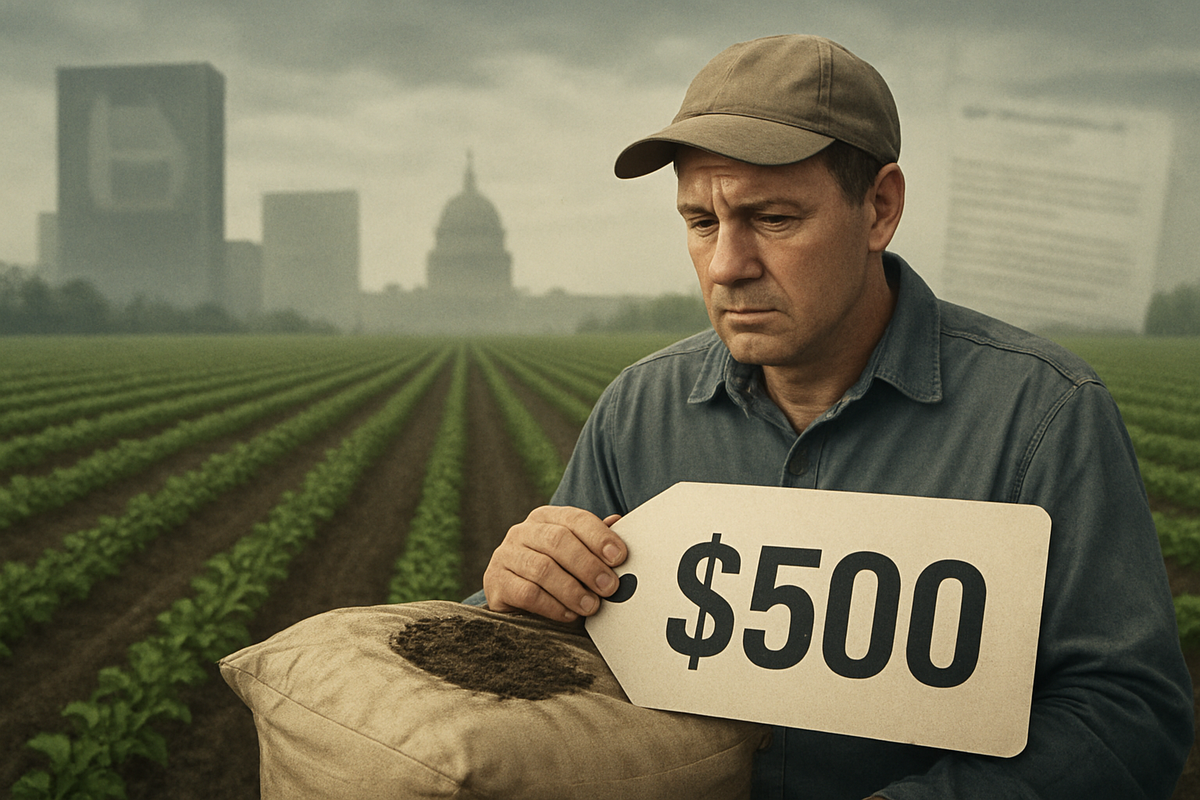Senate Grills Ag Giants Over Soaring Input Costs and Opaque Markets Amid Consolidation Fears

Washington D.C. – October 28, 2025 – Today, the agricultural industry faces a reckoning on Capitol Hill as the Senate Judiciary Committee convenes a critical hearing titled "Pressure Cooker: Competition Issues in the Seed and Fertilizer Industries." Chaired by Senator Chuck Grassley (R-Iowa), the session aims to dissect the alarming rise in crop input costs, which farmers nationwide attribute directly to decades of rapid consolidation among seed, chemical, and fertilizer companies. This pivotal hearing, unfolding on October 28, 2025, underscores growing concerns that diminishing competition and a pervasive lack of market transparency are squeezing farmer profits and threatening the viability of America's agricultural backbone.
The immediate implications of this inquiry are profound, casting a spotlight on the concentrated power of a few agricultural behemoths and their impact on the nation's food producers. As farmers grapple with unprecedented financial pressures, the Senate's focused examination could pave the way for increased regulatory oversight, legislative action to restore competition, and mandates for greater transparency in a market often perceived as opaque. The outcome could reshape the competitive landscape for agribusiness, offering a glimmer of hope for struggling farmers while signaling potential challenges for dominant industry players.
The Squeeze on America's Farms: A Deep Dive into Congressional Scrutiny
The Senate Judiciary Committee hearing today, October 28, 2025, served as a powerful platform for farmers and industry experts to voice their grievances against what they describe as an increasingly uncompetitive agricultural input market. Senator Grassley, a long-time advocate for farmers, opened the proceedings by highlighting the dramatic increase in essential farming costs. Testimonies revealed that since early 2021, seed prices have surged by 18%, fertilizer by 37%, pesticides by 25%, machinery by 23%, and interest expenses by a staggering 37%. These increases, presented by figures like American Soybean Association President Caleb Ragland, occur even as commodity prices have seen declines, creating an unsustainable economic environment for many producers.
The timeline leading to this critical juncture spans decades of aggressive mergers and acquisitions. Over the past twenty years, a handful of dominant corporations have systematically absorbed smaller seed and chemical companies, creating integrated packages of seeds, pesticides, and digital farming tools. By 2017, just four companies controlled approximately 80% of the U.S. corn seed market and 75% of the soybean seed market. Similarly, the fertilizer industry is now predominantly controlled by four major players. This market concentration, exacerbated by intellectual property expansion, has resulted in a "lock-in" effect, making it difficult for farmers to switch brands or find competitive alternatives.
Key players and stakeholders involved in this ongoing debate include Senator Grassley and his congressional allies pushing for antitrust enforcement, farmer advocacy groups like the American Soybean Association, and individual farmers such as Iowa's Noah Coppess, who testified about the struggles small agricultural businesses face in accessing wholesale products. Representing the industry, Corey Rosenbush, President and CEO of The Fertilizer Institute, acknowledged that geopolitical factors, such as China's export restrictions and Middle East conflicts, also contribute to supply chain disruptions and price volatility. However, critics argue these external factors only exacerbate an already fragile market structure dominated by a few powerful entities. The initial reactions from the farming community are a mixture of cautious optimism for change and deep-seated frustration over years of unchecked consolidation.
Market Movers: Who Gains and Who Loses in a Consolidated Landscape
In this increasingly consolidated agricultural landscape, the clear beneficiaries have been the few dominant multinational corporations that have strategically acquired competitors and expanded their market share. Companies such as Bayer AG (OTCMKTS: BAYRY), through its acquisition of Monsanto, Corteva Agriscience (NYSE: CTVA), formed from the merger of Dow and DuPont agricultural divisions, BASF SE (OTCMKTS: BASFY), and Syngenta AG (OTCMKTS: SYT), a subsidiary of ChemChina, now wield immense pricing power and control over vast segments of the seed and crop protection markets. In the fertilizer sector, major players like Nutrien Ltd. (NYSE: NTR) and The Mosaic Company (NYSE: MOS) command significant influence. These firms benefit from economies of scale, integrated product offerings, extensive patent portfolios, and reduced competitive pressure, allowing them to dictate terms and prices for essential farm inputs. Their ability to bundle products and leverage data from digital farming platforms further entrenches their market position, contributing to their robust financial performance even as farmer profits dwindle.
Conversely, the primary losers in this scenario are the independent farmers and smaller agricultural businesses. They face a limited choice of suppliers, making them vulnerable to rising input costs with little recourse. The lack of price transparency, particularly in the fertilizer market, means farmers often struggle to understand the true cost of their purchases, including the impact of complex rebates and clawbacks. This opacity prevents them from making informed purchasing decisions and comparing prices effectively. Smaller farmers are at a distinct disadvantage, often unable to secure the same competitive pricing or credit terms as larger agribusinesses due to their lower volume. This economic squeeze threatens their livelihoods, forces some out of business, and contributes to the ongoing decline of independent family farms across the nation. The consolidation also stifles innovation from smaller, independent research firms and seed developers, as the path to market becomes increasingly dominated by the few large players.
Broader Implications: A Shifting Agricultural Paradigm
The concerns aired in the Senate committee hearing are not isolated incidents but rather symptomatic of broader, long-term trends reshaping the global agricultural industry. The drive towards consolidation reflects a strategy by large corporations to achieve greater efficiency, control supply chains, and leverage intellectual property in an increasingly complex and technologically driven farming environment. This trend extends beyond seeds and fertilizers to agricultural machinery, food processing, and distribution, creating a highly integrated and concentrated food system. The ripple effects are significant: reduced competition can lead to less innovation tailored for diverse farm needs, higher prices for consumers down the line as increased farm costs are passed on, and a diminished voice for individual farmers in the marketplace.
Regulatory and policy implications are now at the forefront. Senator Grassley's proposed "Fertilizer Research Act," which calls for a comprehensive study of the fertilizer industry and regular public reporting on pricing factors, signals a legislative push for greater transparency. This aligns with the Biden Administration's Executive Order 14036 from July 9, 2021, aimed at "Promoting Competition in the American Economy," which specifically identified agriculture as an industry negatively affected by consolidation. Furthermore, the Department of Justice (DOJ) and Federal Trade Commission (FTC) issued new Merger Guidelines in 2023, indicating a more aggressive stance on assessing mergers for their competitive impact, particularly in concentrated markets. Historically, periods of rapid industrial consolidation have often been followed by waves of antitrust scrutiny and regulatory intervention, drawing parallels to early 20th-century trust-busting efforts in other foundational industries. The current moment suggests a potential turning point where policymakers are increasingly willing to challenge the status quo in agriculture.
The Road Ahead: Navigating an Evolving Market
Looking ahead, the short-term possibilities stemming from today's Senate hearing include increased regulatory scrutiny of proposed agricultural mergers and acquisitions, potentially leading to more stringent review processes or even blockages. There could also be a push for immediate legislative action to mandate greater price transparency in input markets, particularly for fertilizers, and to protect farmer data ownership. Farmers might see some relief if these measures lead to even marginal reductions in input costs or foster more competitive local markets. For the dominant agricultural companies, strategic pivots may be necessary, potentially focusing more on value-added services or sustainable farming solutions rather than solely relying on price leverage from market dominance.
In the long term, the landscape could see more significant restructuring. If antitrust enforcement strengthens, it might encourage new entrants or foster the growth of smaller, innovative companies offering alternative inputs or services. This could create market opportunities for technology providers focusing on precision agriculture that reduces reliance on traditional inputs, or for companies developing biological alternatives to chemical pesticides and synthetic fertilizers. However, challenges persist, including the immense capital required to compete with established giants and the complexity of breaking down deeply entrenched market structures. Potential scenarios range from a gradual rebalancing of power towards farmers through sustained regulatory pressure to a continued struggle if legislative efforts falter, leaving farmers vulnerable to ongoing cost pressures and market opaqueness.
Conclusion: A Call for Balance in the Agricultural Economy
The Senate Judiciary Committee's hearing on agricultural industry consolidation and its impact on crop input costs marks a significant moment for the nation's food system. The key takeaway is clear: unchecked market concentration has led to substantial financial burdens for farmers, eroding competition and fostering an environment of limited transparency. This situation not only threatens the economic viability of individual farms but also raises questions about the long-term resilience and fairness of the entire agricultural supply chain.
Moving forward, the market will be defined by the interplay between powerful agribusinesses, determined farmer advocacy, and evolving regulatory frameworks. A critical assessment of market power and a commitment to fostering genuine competition are essential to ensure a healthy, equitable, and sustainable agricultural future. Investors should closely watch for legislative developments, particularly the progress of bills like the "Fertilizer Research Act," and any shifts in antitrust enforcement by the DOJ and FTC. The response of major agricultural companies to these pressures, their strategies for innovation, and their willingness to engage in more transparent practices will also be crucial indicators of the market's trajectory in the coming months. The balance between corporate efficiency and farmer prosperity hangs in the balance, and the decisions made now will have lasting impacts on every plate in America.
This content is intended for informational purposes only and is not financial advice



